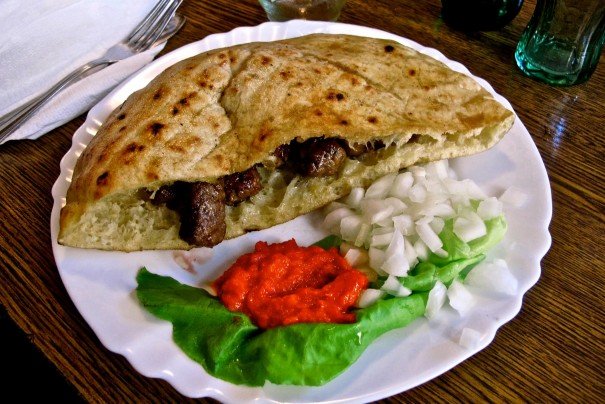
The Many Names of the Quintessential Balkan Dish

The Many Names of the Quintessential Balkan Dish
Ćevapčići in Bosnia-Hercegovina
With a brusque grunt, the border guard shoves my passport back into my hand and moves on. I stare forward in the crowded bus, taking in the lingering aroma of stale cigarette smoke and hoping he doesn’t come back. Others shuffle just as uncomfortably as we are waved out of Montenegro and into Bosnia and Herzogovina.
As the light fades we link up to the jade waters of the Nertva river and follow the winding road up to Mostar. The orange-roofed Orthodox monasteries that peppered the coast along the Montenegrin Bay of Kotor have given way to starker, humbler mosques, their simplicity of structure belying past glory, provincial jewels in the Ottoman crown. The landscape changes: we penetrate deeper into hilly Herzegovina, “Duke’s Land,” and the limestone brings a harshness to the earth.
We pull into Mostar, exhausted, and as I wait to collect my luggage from under the bus I glance around the crumbling station to see pock-marked buildings, wounds that still seem fresh from the Yugoslav collapse of the early 1990s. I’m jarred as I amble the short walk to my hostel; I expected the remnants of war, but not such a stark contrast to the pristine Adriatic villages of Croatia, which seemed to have escaped (or at least more quickly recovered from) the brunt of the war’s physical toll.
The next morning, the gorgeous city throws the conflict into physical relief. I stroll into the heart of town to see what brought me all the way here: Stari Most, Mostar’s famous Old Bridge, built by the Ottomans in the 16th-century in classical Islamic style and which stood as a symbol of multicultural unity until it was destroyed in 1993 by artillery fire. Rebuilt in 2004, it now splits the Catholic, Croat side of the city in the west from the Muslim, Bosniak side on the east, keeping a cautious peace. On the day of my visit, locals are jumping the 78-foot bridge into the river below every few hours, and a relaxed way of life seems to dominate. I join other tourists in admiring their bravado as I focus on a most pressing task: getting something to eat.
Ćevapčići is the quintessential Balkan dish, smoky links of minced meat served at any hour, with rotating combinations of chopped onions, sour cream, and ajvar, a mildly spicy, garlicky, bell-pepper relish. I order up a plate with all the fixings, pointing to the picture on my laminated menu and sparing both myself and the server the embarrassment of twisting my tongue in a knot. I’m seated at an outdoor table, squinting through the sunlight reflected off the shiny, trodden cobblestone to a full view of Stari Most and the surrounding city center.
As I dive into my breakfast I contemplate the complexities of my three-country tour through the former Yugoslavia. I linger on my menu, noticing that my Ćevapčići in Bosnia sure tastes similar to the Ćevapi in Croatia, and remember that my bungled attempts to pronounce what some refer to as Croatian, Montenegrin, or Bosnian all refer back to the same Serbo-Croatian language, which I patently do not speak. Full, I clean my plate of the last vibrant red specks of ajvar and glance back at the bridge, both what it unites and what it divides.